Owais Mughal
It is 8:00 a.m. on a sunny Sunday at Peshawar cantonment. The Steam locomotive number 2216, which was built in 1916 by Kitson and Company of Leeds, UK is all set to start on yet another journey. The driver and fireman give one final inspection to the engine vitals and with a long whistle the number 2216 coupled to a tourist train pulls out of the station. Today the destination is Landi Kotal via Khyber Pass.
It is 8:00 a.m. on a sunny Sunday at Peshawar cantonment. The Steam locomotive number 2216, which was built in 1916 by Kitson and Company of Leeds, UK is all set to start on yet another journey. The driver and fireman give one final inspection to the engine vitals and with a long whistle the number 2216 coupled to a tourist train pulls out of the station. Today the destination is Landi Kotal via Khyber Pass.
Railtracks across a Runway
 The train gains speed and soon passes through Peshawar localities of Notia Gate, Swati Gate and Bara Gate. Since the track is now seldom used, there are vehicles parked very close to the track. Many children run along and clap as they see the approaching train. After crossing Bara Gate the train slows down and ultimately comes to a full stop. In front of the locomotive lies the 9000 ft long runway of Peshawar International Airport. The train now waits for clearance from the airport control tower before it could move. Peshawar is the only international airport in the world where a rail track crosses the main runway. The photo to the left is the satellite image of Peshawar airport's main runway. The diagonal path crossing the runway is the Peshawar - Landi Kotal rail track. After clearance is received from the control tower, the train chugs forward.
The train gains speed and soon passes through Peshawar localities of Notia Gate, Swati Gate and Bara Gate. Since the track is now seldom used, there are vehicles parked very close to the track. Many children run along and clap as they see the approaching train. After crossing Bara Gate the train slows down and ultimately comes to a full stop. In front of the locomotive lies the 9000 ft long runway of Peshawar International Airport. The train now waits for clearance from the airport control tower before it could move. Peshawar is the only international airport in the world where a rail track crosses the main runway. The photo to the left is the satellite image of Peshawar airport's main runway. The diagonal path crossing the runway is the Peshawar - Landi Kotal rail track. After clearance is received from the control tower, the train chugs forward.After clearing runway the train passes through the localities of University town, Kacha Garhi and Hayatabad. The famous 1756 km long Karachi-Torkham highway N5 comes closer to the rail track and both start traveling in parallel towards Jamrud. 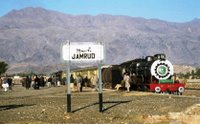 Located 18 km west of Peshawar, Jamrud is the gateway to Khyber Pass. The train reaches Jamrud in a less than an hour and and after a short stop continues its journey westward into the Khyber Pass. The photo to the right shows the arrival of a tourist train at Jamrud station
Located 18 km west of Peshawar, Jamrud is the gateway to Khyber Pass. The train reaches Jamrud in a less than an hour and and after a short stop continues its journey westward into the Khyber Pass. The photo to the right shows the arrival of a tourist train at Jamrud station
 Located 18 km west of Peshawar, Jamrud is the gateway to Khyber Pass. The train reaches Jamrud in a less than an hour and and after a short stop continues its journey westward into the Khyber Pass. The photo to the right shows the arrival of a tourist train at Jamrud station
Located 18 km west of Peshawar, Jamrud is the gateway to Khyber Pass. The train reaches Jamrud in a less than an hour and and after a short stop continues its journey westward into the Khyber Pass. The photo to the right shows the arrival of a tourist train at Jamrud stationWhile the train is slowly steaming through its 3 hour journey towards Landi Kotal, how about if we take a detour of about 150 years and cover the history of railways in Khyber. We will catch the train again as it will be entering the Landi Kotal platform around noon.
History of Khyber Pass Railway
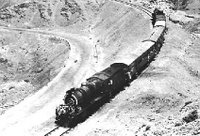 Let us go back in time to the year 1857. The ‘Great Game’ is being played between the World powers on the chess board of central and south Asia. Russian influence is present in Afghanistan and British think there is a big possibility of Russian invasion into India. The most obvious routes for this possibility will be through Khyber or Bolan Pass. Therefore it is suggested that strategic railways be built in both of these passes to thwart any Russian invasion in to India.
Let us go back in time to the year 1857. The ‘Great Game’ is being played between the World powers on the chess board of central and south Asia. Russian influence is present in Afghanistan and British think there is a big possibility of Russian invasion into India. The most obvious routes for this possibility will be through Khyber or Bolan Pass. Therefore it is suggested that strategic railways be built in both of these passes to thwart any Russian invasion in to India. The black and white photo to the left above shows a train through Khyber Pass in 1970.
In 1878, second Anglo-Afghan war (1878-1880) takes place and it makes it all the while more important to lay a railway track through western passes of India. In 1879 a reconnaissance survey is conducted with an aim to find the feasibility of laying railways through Khyber Pass. In 1880, a British engineer named Victor Bailey is entrusted for making plans for laying a meter-gauge (1000 mm) railway through Khyber Pass. Many years pass without any action on the ground. Finally the construction starts in 1905 from a place called Kacha Garhi between Peshawar and Jamrud. The track makes progress westwards and 32 km of track is laid by 1907.
International situation changes soon and an alliance takes place between Russia and Afghanistan. Russia agrees to consider Afghanistan out of its circle of influence countries. British now considerRussia as no longer a threat as it used to be. This stops the work on Khyber Railway. In 1909, several kilometers of permanent way and bridges are uprooted from Khyber Pass and sent to other areas of India to be used there.
As it goes with the World politics, international situation changes again and the third Anglo-Afghan war of May 1919 brings life back to Khyber Pass Railway project. 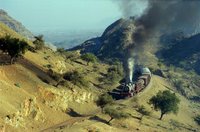 Colonel Gordon Hearn is now assigned the work to survey and recommend the best route through Khyber Pass. Until now all surveys recommended a meter gauge (1000 mm) track. Gordon Hearn proposes and demonstrates by a masterly survey that broad-gauge (1676 mm) line can be laid through the pass.
Colonel Gordon Hearn is now assigned the work to survey and recommend the best route through Khyber Pass. Until now all surveys recommended a meter gauge (1000 mm) track. Gordon Hearn proposes and demonstrates by a masterly survey that broad-gauge (1676 mm) line can be laid through the pass.
 Colonel Gordon Hearn is now assigned the work to survey and recommend the best route through Khyber Pass. Until now all surveys recommended a meter gauge (1000 mm) track. Gordon Hearn proposes and demonstrates by a masterly survey that broad-gauge (1676 mm) line can be laid through the pass.
Colonel Gordon Hearn is now assigned the work to survey and recommend the best route through Khyber Pass. Until now all surveys recommended a meter gauge (1000 mm) track. Gordon Hearn proposes and demonstrates by a masterly survey that broad-gauge (1676 mm) line can be laid through the pass. Who drove the first train in Khyber Pass?
Construction restarts in 1920 and the section from Jamrud to Landi Kotal, opens on November 3, 1925. Next day on November 4, Mrs. Victor Bailey, wife of the British engineer entrusted with the construction of Khyber Railway drives the first train through Khyber Pass. There are two stories as to why Mrs. Victor Bailey drove the first train through the pass.
- It was decided by the British government that Victor Bailey will run the inaugural train as recognition of his great work at the project but he died three months before the inauguration. His wife then honored the driving of train on her husband’s behalf.
- According to second version, as the track was being laid, the locals of the Khyber Agency did not allow the train to move on it. However, knowing the traditional respect the Pathans have for women, Victory Bailey, asked his wife to drive the first train in the Khyber Agency. It has been reported that she drew long hair so that she could be identified as a women from a distance.
 On April 3, 1926 another portion of 8 km track is opened up to Landi Khana which fall just 3 km short of the actual frontier post of Torkham. The photo in sepia to the left is from April 27, 1932. It shows a tunnel on Khyber Pass railway alongwith (now highway) N5 which runs alongside the track. On December 15, 1932 the Landi Kotal to Landi Khana section of railway is closed down at the insistence of Afghan Government.
On April 3, 1926 another portion of 8 km track is opened up to Landi Khana which fall just 3 km short of the actual frontier post of Torkham. The photo in sepia to the left is from April 27, 1932. It shows a tunnel on Khyber Pass railway alongwith (now highway) N5 which runs alongside the track. On December 15, 1932 the Landi Kotal to Landi Khana section of railway is closed down at the insistence of Afghan Government. The Cost of Construction
The cost of building Khyber Pass railway was accounted as Rupees 485000 per kilometer in 1926. despite this exorbitant cost of construction, Khyber Pass has never seen heavy rail traffic. At best there were only 2 trains per week here. Scenery wise Khyber Pass is also not an eye catch either but the feature that sets it apart from other railways in the region is the engineering aspect of it.
Engineering Features of Khyber Pass Railway
 The Khyber Pass railway has a ruling gradient of 3 percent between Jamrud and Landi Kotal. There is a rise of nearly 2000 feet in 34 kilometers, and a drop of 872 feet in the next 8 kilometers to Landi Khana, where in many places the gradient stiffens to 1 in 25. There are 4 reversing stations, 34 tunnels with an aggregate length of more than 4 kilometers, 92 bridges and culverts, and 4 locomotive watering stations. And during the construction, three million cubic yards of materials mainly rock, were moved in the cuttings and embankments.
The Khyber Pass railway has a ruling gradient of 3 percent between Jamrud and Landi Kotal. There is a rise of nearly 2000 feet in 34 kilometers, and a drop of 872 feet in the next 8 kilometers to Landi Khana, where in many places the gradient stiffens to 1 in 25. There are 4 reversing stations, 34 tunnels with an aggregate length of more than 4 kilometers, 92 bridges and culverts, and 4 locomotive watering stations. And during the construction, three million cubic yards of materials mainly rock, were moved in the cuttings and embankments. Reversing Stations and Catch sidings
 Reversing stations are an important feature of Khyber Railways. Since it is not easy to bend a train here due to tight space, trains switch tracks and engines change direction at the reversing station. The Khyber Railways is the last of the great railway constructions undertaken on the frontier during the British Raj. Besides reversing stations, track at numerous places is also provided with the runway train catch sidings. One such catch siding is shown in the photo on the left.
Reversing stations are an important feature of Khyber Railways. Since it is not easy to bend a train here due to tight space, trains switch tracks and engines change direction at the reversing station. The Khyber Railways is the last of the great railway constructions undertaken on the frontier during the British Raj. Besides reversing stations, track at numerous places is also provided with the runway train catch sidings. One such catch siding is shown in the photo on the left.From 1947 onwards, Pakistan Railway has continued a weekly passenger service through Khyber Pass. The service runs free of charge simply as a gesture to prove to the fiercely independent tribesmen that the line, in-spite of them, is open and the Pakistan Government is the boss. The regular service in Khyber Pass stopped in 1982 due to the lack of commercial patronage.
Khyber Steam Safari Schedule for 2006
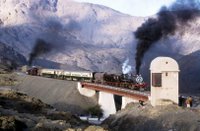 Due to axle load limitations, diesel engines cannot run on this track. Therefore Khyber Pass railway to date is served by steam locomotion only. At present a tourist train called the 'Khyber Steam Safari' is operated here by a privately owned tourist company. The train runs few times a year on scheduled days as well as it can be chartered too.
Due to axle load limitations, diesel engines cannot run on this track. Therefore Khyber Pass railway to date is served by steam locomotion only. At present a tourist train called the 'Khyber Steam Safari' is operated here by a privately owned tourist company. The train runs few times a year on scheduled days as well as it can be chartered too.For the remaining part of 2006, Pakistan Tourism Development Corporation (PTDC) in collaboration with PRACS and Sehrai travels will be running the Khyber Steam Safari trains on October 1, November 5 and December 3, 2006. For reservations you can call the UAN 111-366-366. Telephone number of Sehrai travels in Peshawar is 92-91-5272084/5
Locomotives Serving the Khyber Pass Railway
As of summer 2006, Peshawar shed is maintaining 3 HGS steam engines which are used on this tourist train called the Khyber Steam Safari. All of these are in working condition (as of 2006) and their details are as follows: 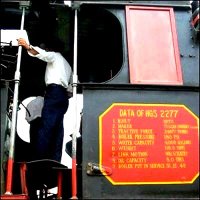

- 2-8-0 HG/S Serial # 2216 built by Kitson and Co, of Leeds UK in the year 1916
- 2-8-0 HG/S Serial # 2277 built Vulcan foundry in the year1923, and
- 2-8-0 HG/S Serial # 2306 built Vulcan foundry in the year1923.
 This completes the brief history of Khyber railway. It is around noon now. Let us now go to Landi Kotal station where our train which we parted in Jamrud is arriving. The station gives a festive look. The trains in Khyber Pass run seldom now therefore many locals have showed up at the station to welcome the train. Landi Kotal station is built in a very unique fortress like architecture. There are no windows or doors on the forbidding facade facing the platform.
This completes the brief history of Khyber railway. It is around noon now. Let us now go to Landi Kotal station where our train which we parted in Jamrud is arriving. The station gives a festive look. The trains in Khyber Pass run seldom now therefore many locals have showed up at the station to welcome the train. Landi Kotal station is built in a very unique fortress like architecture. There are no windows or doors on the forbidding facade facing the platform. Distance and Altitudes on Khyber Pass Railway
Considering Peshawar Cantt as 0 km, following table gives a view of distances and altitude of different landmarks along Khyber Pass Railway.
- (0 km) Peshawar Cantt 1048 ft
- (18 km) Jamrud 1496 ft
- Bagiari 1837 ft
- Medanak (1st Reversing Station) 2086 ft
- (34 km) Chagai (2nd Reversing Station) 2270 ft
- Shahgai 2265 ft
- Kata Kushta 2799 ft
- Zintara 3114 ft
- Sultan Khel 3293 ft
- (52 km) Landi Kotal 3494 ft
- Tora Tigga (3rd Reversing Station) 2876 ft
- (60 km) Landi Khana (4th Reversing Station) 2622 ft

The photo above shows the arrival of Sunday passenger at Landi Kotal in 1975.
Chronology of Khyber Pass Railway
As an appendix, I want to give the chronology of important dates regarding Khyber Pass Railway in the following.
1857: Chairman of Scinde, Punjab and Delhi Railway Company, Mr. William Andrew proposes rail routes through Khyber and Bolan passes.
1878: Second Anglo-Afghan war takes place
1879: Sir Guilford Molesworth, an English Civil Engineer who was consulting for Indian government considered a survey of meter gauge (1000 mm) railway through Khyber Pass.
March 27, 1880: A news appears in the Morning Post newspaper announcing the construction of Khyber Pass Railways. An excerpt from the news goes like this: "After three and twenty years of apathy the necessity has been realized and now these railways are being constructed."
1880: An engineer by the name of Victor Bailey is entrusted with the actual construction of Khyber Pass railways.
1885: Another survey was conducted by Captain JRL McDonald up to Landi Kotal.1890: Captain JRL McDonald surveys another route to Khyber Pass following the gorge of River Kabul.
1898: One more survey was conducted to lay railways through Khyber Pass.1901: Broad Gauge (1676 mm) track is completed from Peshawar to Jamrud.
1905: Work started on laying an alternate meter gauge route following River Kabul into Mullagori hills.
1907: 32 km of broad gauge track was completed from Kacha Garhi to west of Jamrud into Loi Shilman valley.
August 31, 1907: Britain and Russia decide on an accord in St Petersburg. According to this agreement Britain will not annex or occupy Afghanistan and in return Russia will not consider Afghanistan a country of influence.
1909: Kabul River Railway is abandoned as threat from Russia is considered very low.1919: Third Anglo-Afghan war takes place. Col Gordon Hearn plans a broad gauge Khyber Pass railway from Jamrud westwards.
1920: Construction of railways restarts west of Jamrud
November 3, 1925: Khyber Pass railway is inaugurated up to Landi Kotal.
November 4, 1925: First train runs on Khyber Pass railway. Train is driven by Mrs Victor Bailey.
April 23, 1926: Khyber Pass railway is extended to Landi Khana.
1926: Tracks were laid from Landi Khana to the border post at Torkham but a train never traveled on them.
December 15, 1932: Landi Kotal to Landi Khana section is closed on requests from Afghan government.
August 14, 1947: Pakistan gets independence and a weekly Sunday service to Landi Kotal continues
1982: Regular service to Landi Kotal is suspended because of lack of commercial value.mid 1990s: A tourist train called ‘Khyber Steam Safari’ is started by a private enterprise in collaboration with Pakistan railways. This train is still in operation as of 2006. It runs on designated days a year and can be chartered too.
Video of Khyber Steam Safari 2004
An amateur video of Khyber Steam Safari 2004 is here. Copyrights belong to the link owner.
Photo Credits
Mr. Peter Patt, Mr. Zakir Khan and Mr Rana Rashid, Dr. Roland Ziegler and Mr. Nick Lera
References
- Couplings to Khyber by P.S.A Berridge, 1968
- Hundred Years of Pakistan Railway, M.B.K Malik, 1962
- North Western Railway Time Table, November 1959
- The Imperial Way by Paul Theroux, 1985
- Andrew Grantham's page here
- Dr. Roland Ziegler’s page on Pakistan tour of 1996 here.
- Khyber Railway preservation Society of Pakistan here
- Dr Ken J Walker at here
- Mr. Rob Dickinson here
- Pakistan Railway Newsgroup here
- Illustrated Book of Steam and Rail by Colin Garratt, 2002


No comments:
Post a Comment